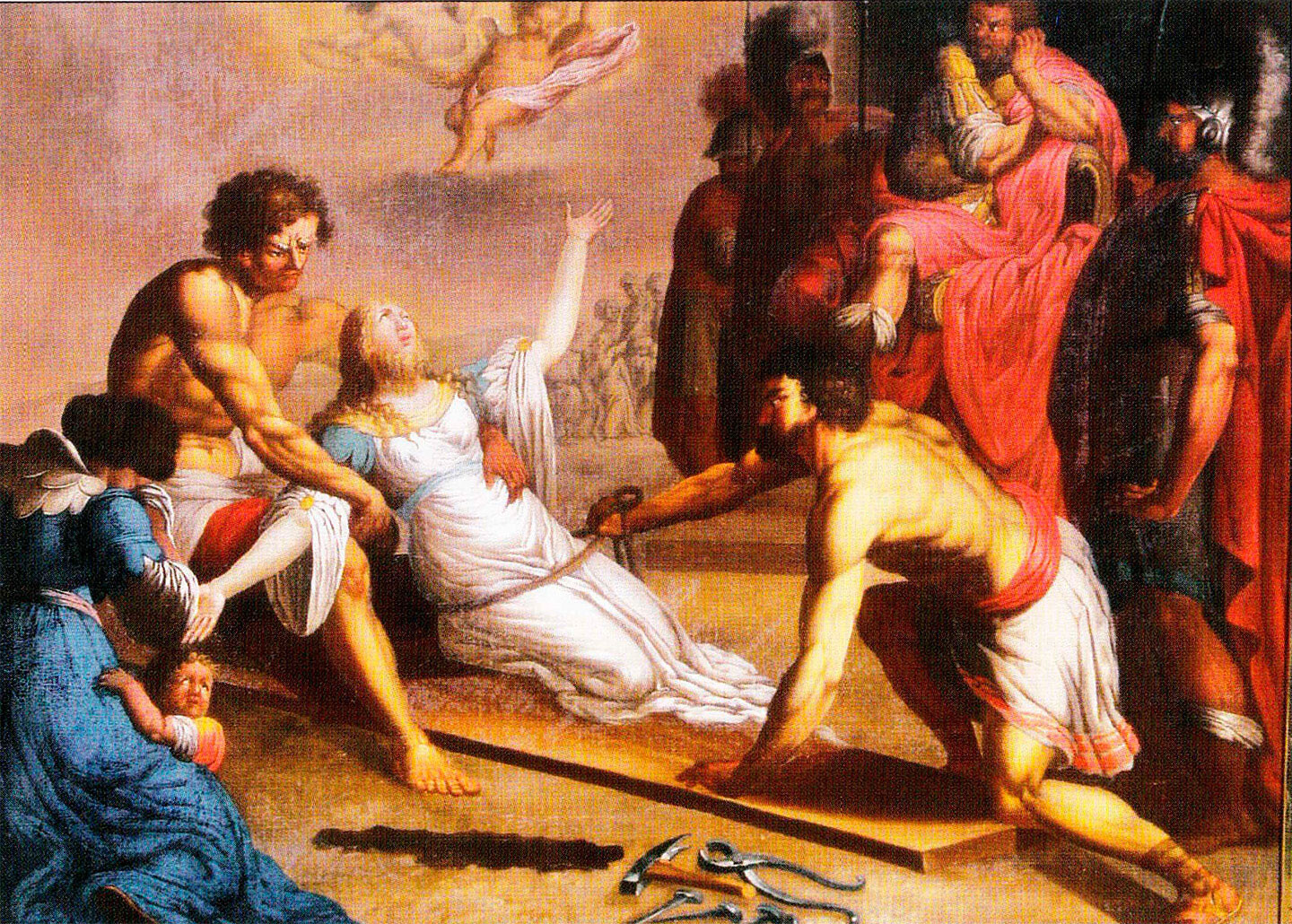History is not the past. It is the stories we tell about the past. How we tell these stories—triumphantly or self-critically, metaphysically or dialectically—has a lot to do with whether we cut short or advance our evolution as human beings.
—Grace Lee Boggs1
Part 1: Her Second Coming
The Nailing of the Cross of St. Kümmernis depicts the fourteenth-century crucifixion of St. Wilgefortis, a medieval bearded female saint. The early nineteenth-century painting by Leopold Pellaucher replaced another depiction of the saint at St. Veits Chapel in Austria, which had been destroyed by an overzealous Franciscan clerk. Rather than the typical image of Wilgefortis already nailed to the cross, Pellaucher opted to depict the scene leading up to her crucifixion, showing a distressed St. Wilgefortis, an angry father who has ordered his daughter’s execution, and weeping female witnesses to the martyrdom.2 In choosing this moment, the painting also equates Wilgefortis’s crucifixion with the rebirth or renewal associated with generic Christian interpretations of Christ. Christ’s crucifixion is symbolic of a second coming, his resurrection; Wilgefortis’s “second coming” is perhaps representative of a necessary escape to a separate life in order to begin anew.
Originally either a pagan noblewoman or the princess of Portugal (her origins are disputed), St. Wilgefortis was promised to a suitor by her father.3 The suitor’s identity is also disputed. Some accounts identify him as a non-Christian and say that Wilgefortis wished to keep her Christian body pure.4 Either way, she did not wish to wed this man, and the night before her wedding she prayed to God to make her repulsive to the suitor. When she awoke she found that she had grown a beard. The suitor called off the wedding and her father, enraged, had Wilgefortis crucified.
St. Wilgefortis came to be the patron saint of relief from tribulations. Historically, she has been venerated by those who wish to be disencumbered, in particular by women who wish to be liberated from abusive husbands or domestic situations, as well as by survivors of sexual assault, rape, and incest. She has also been historically worshipped by those who are bound or restricted, and thus by prisoners and others in captivity. In various regions and time periods she has been known by other names, such as St. Kümmernis (Germany), St. Uncumber (England), and St. Liberata (Italy). I will refer to her here as St. Wilgefortis.
In the latter half of the twentieth century, most of the shrines and likenesses of St. Wilgefortis were destroyed or left to deteriorate after the suppression of her sainthood during the Catholic liturgical purge of 1969.5 Art historian Ilse E. Friesen, who has done extensive research on the visual representations of Wilgefortis, states that the presence and worship of this saint became identified with anti-Christian, anti-Catholic, and deviant behavior. Her gender presentation was seen as grotesque and a denigration of Christ. Her suppression led to the loss of a saint that offered visibility to survivors of abuse and assault. We must also recognize this loss as a part of the continual erasure of violence against women, trans, and nonbinary people. In contemporary times she has also been interpreted by some as the patron saint of intersex people, asexual people, transgender people, and a powerful lesbian virgin.

Myself below Kummerniskreuz statue from the 12th century. Church of Rankweil, Austria, 2019.

St. Wilgefortis sculpture from the 1730s in the Chapel of Our Lady of Sorrows at Loreto Sacntuary, Prague, Czech Republic, 2019.
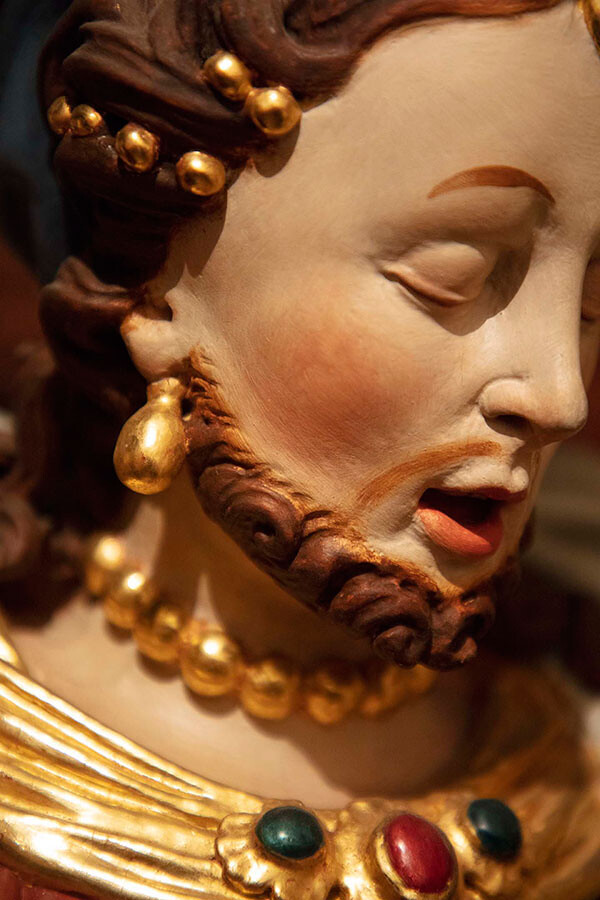
St. Kummernus sculpture from the 18th century. Previously this sculpture was housed in the Chapel St. Michael and Kummernus at the Church of Axams, Austria. It has since been put in offsite storage—I discovered when I went to visit in the summer of 2019.
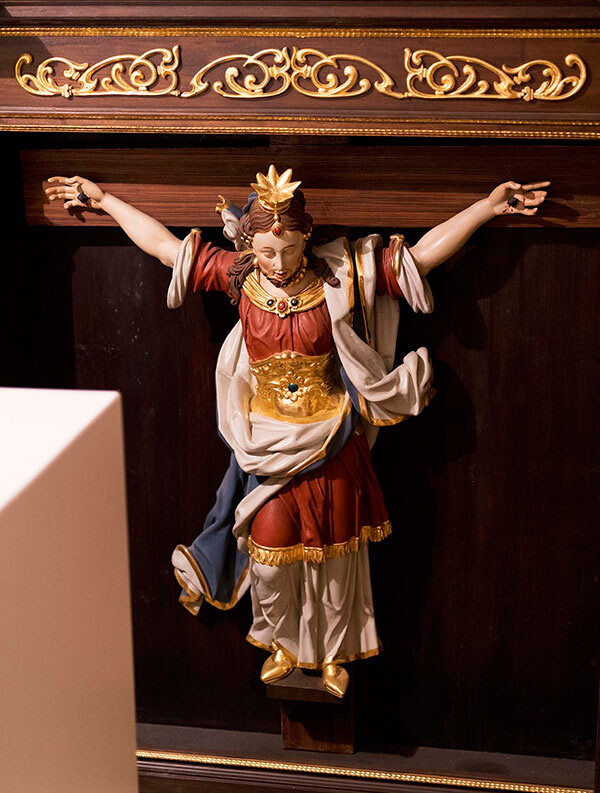
St. Kummernus sculpture, Chapel St. Michael and Kummernus at the Church of Axams, Austria.

S. Wilgefortis Sive Liberata is a Romanesque sculpture inside a Baroque altar dating from 1661, Church of Neufahrn, Bavaria. This was the only church I visited that was locked, and the only church known to be explicitly dedicated to St. Wilgefortis.

Kummerniskreuz, portrayed here, is a statue from the 12th century in the Church of Rankweil, Austria, 2019.
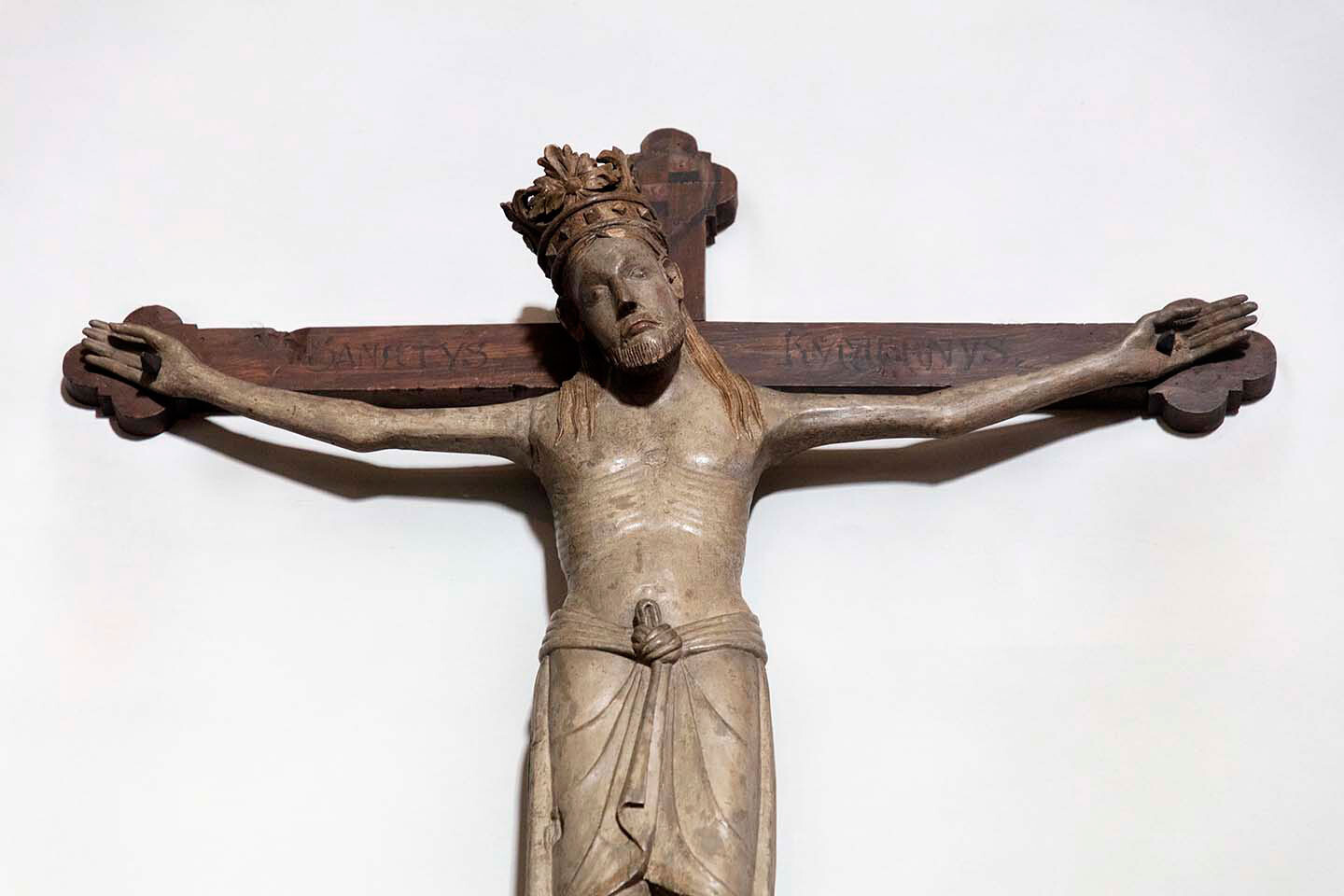
Kummerniskreuz statue from the 12th century. Church of Rankweil, Austria, 2019.
Myself below Kummerniskreuz statue from the 12th century. Church of Rankweil, Austria, 2019.
There have been instances, in particular at sites in the Tyrolean region of western Austria, where carvings or renditions of Christ have been remade or altered to be Wilgefortis. This act is a queering of the body of Christ. Subtly, this radical gesture creates a visual history of the queer body. The most notable and surviving example of this is in Brixen, at the northern tip of Italy. Friesen writes of this statue:
On certain religious holidays, this venerated statue was decorated with costly garments, lace accessories, pieces of jewelry and precious shoes … These items, once placed on the statue, made it appear more feminine and ornate. Ironically it does not seem to have been the intention of these believers to transform the gender of the statue through these sartorial additions.
Nevertheless, the dramatic contrast between the adorned and the unadorned statue left visitors with two radically differing impressions—one of the unadorned statue itself (generally recognizable as being male, in spite of the long robe that constituted part of the carving), the other, its lavishly dressed and more apparently feminine counterpart. With the passage of time and the increasingly creative copying of the time in distant locations, it was often left up to individual believers to determine for themselves the extent to which the statue could be regarded as either male or female—or even both at once.6
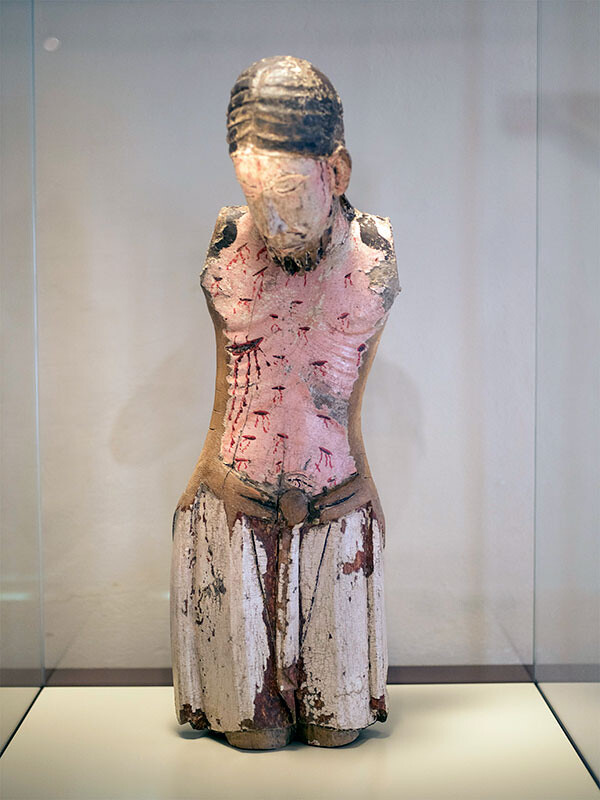

What remains of a sculpture of St. Wilgefortis modified to resemble Jesus Christ. Brixen, Italy. Photo by the author.
I went to Westminster to find St. Wilgefortis. Supposedly, there was a remaining sculpture of her in Henry VII’s massive and ornate Lady Chapel. I wandered in and started asking docents where to find her. A younger woman and an older man responded, somewhat excitedly, “Ayy, the one with the beard?” Together, we located her in the upper level of the Lady Chapel. The entire space is lined, up to its high ceilings, with statues of various saints selected by Henry VII. Wilgefortis lives on the left end of a row of five saints, sporting a long beard and reading a book placed upon a pedestal. I had not really thought I would find her. But, there she was, quiet, regal, and beautiful. After we located her, the two guides recommended that I to go to the library, and directed me down a few stone corridors—cloisters—to a large wooden door. I rang its doorbell, and a voice came through a small intercom.
“Hello?”
“Hi, umm, I was wondering if I could talk to someone about a saint?”
“Come in, close the door behind you!”
BUZZ.
Once inside the door, I walked up a creaky staircase to an attic-like space. Ladders leaned against shelves bearing old volumes. It was a small but bountiful library. An endearingly disheveled middle-aged man came to the mezzanine and asked how he could help. He left and came back a few minutes later with a stack of articles and books. I sat at a small desk in a side room to go through them, making notes. An elderly woman sat across the room from me, seemingly charged with making sure that I did not take photos or write on the materials. I did manage to take one selfie. It felt only right to record an important moment I was experiencing all alone.
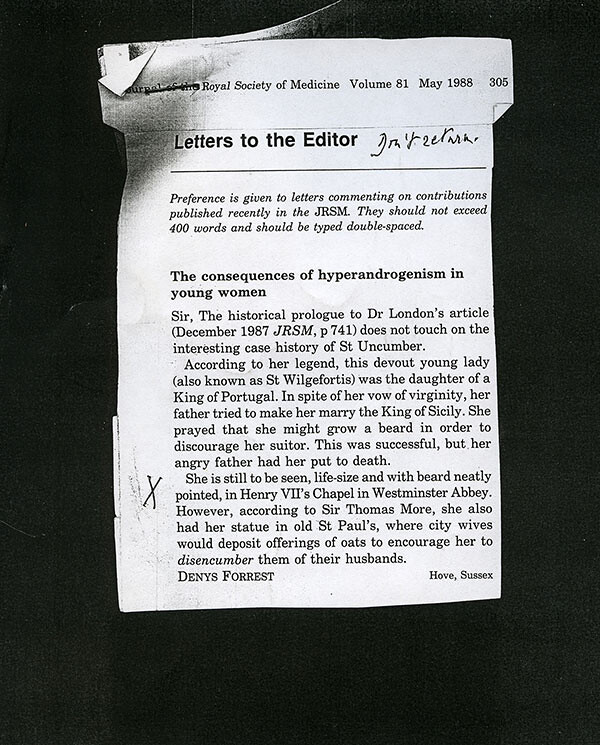

Letter to the Editor, responding to Queen Elizabeth Hospital and Department of Medicine at University of Birmingham, “The Consequences of Hyperandrogenism in Young Women” in Journal of the Royal Society of Medicine, vol. 80 (December 1987).
In the archives, I found the note above attached to a medical article about hyperandrogenism in women, published by the Royal Society of Medicine in 1987. Hyperandrogenism is a condition among people Assigned Female at Birth (AFAB) that is associated with high levels of androgens, or “male” hormones, such as testosterone. The article discussed the biological anatomy of hormones in a very dry and clinical tone. Despite being otherwise uninterested in addressing the sociological effects of said condition, the article began with a brief historical introduction that covered a few recorded instances: Magdalena Ventura, a noblewoman with a full beard who nursed a child and who was idolized as a physical wonder, a fascinating specimen of abnormality; and the witches from Macbeth, who are not of our world and sexless in their ability to control reality.
Not mentioned in the article was Wilgefortis, whose sainted likeness was carved into the hallowed building in which I sat. Wilgefortis is a body doubly suppressed: in life for her gender presentation; and in the afterlife when the Church repressed imagery of her, along with the cult of her martyrdom, due to shifting conceptions of gender. This repression continues, as evidenced by her absence from the academic article on hyperandrogenism. For centuries, then, violence perpetrated against the female/femme, nonbinary, and queer body has been erased.
When does history end and the present begin for the patriarchal gender binary? Queerness and non-cis bodies have always existed, but value and care for their well-being and survival have changed over time. Figures like Wilgefortis show how certain markers of “gender,” as we understand it now, were seen as symbolically and religiously significant in the Middle Ages. As historian Caroline Walker Bynum writes:
Because preachers, confessors, and spiritual directors assumed the person to be a psychosomatic unity, they not only read unusual bodily events as expressions of the soul, but also expected body itself to offer a means of access to the divine. Because they worshiped a God who became incarnate and died for the sins of others, they viewed all bodily events—the hideous wounds of martyrs or stigmatics as well as the rosy-faced beauty of virgins—as possible manifestations of grace. Because they associated the female with the fleshy, they expected somatic expressions to characterize women’s spirituality.7
Take, for instance, beards. Their association with power, regardless of assigned sex, led certain medieval non-male, bearded bodies to gain recognition and respect. Within this history, a “woman” with a beard was something to be marveled at and revered. In fact, beards sometimes protected or freed the women who had them from the particular ridicule and expectations of traditional womanhood.


St. Wilgefortis in Westminster Abbey, Henry VII Lady’s Chapel, London, England.
From Lady Magdalena Ventura of Abruzzi, to Madame Clofullia, to the bearded lady of the circus, there exists a strong, if shifting, foundation in Western history of bearded women finding safety and power beyond gender expectations. This is not to say that bearded women in the medieval era were necessarily beloved, or thought of as beautiful, but they did threaten the established hierarchy of masculinity and power. Mark Albert Johnston, who has researched the politics of the beard in early modern England, writes specifically about St. Wilgefortis:
At stake for early modern English culture in the image of bearded Uncumber [St. Wilgefortis] was not simply male mastery; the more profound threat posed by bearded women and the female autonomy they represented lay in their refusal to submit to the reproductive imperative—an insubordination that threatens the perpetuation of patriarchy itself … Despite the destruction of iconography venerating Uncumber, the threat her bearded specter presented to systems of power in post-Reformation England haunted the early modern cultural imagination, not only informing the values attributed to female beardedness generally but also coloring attitudes toward all independent, unmarried, un(re)productive women.8
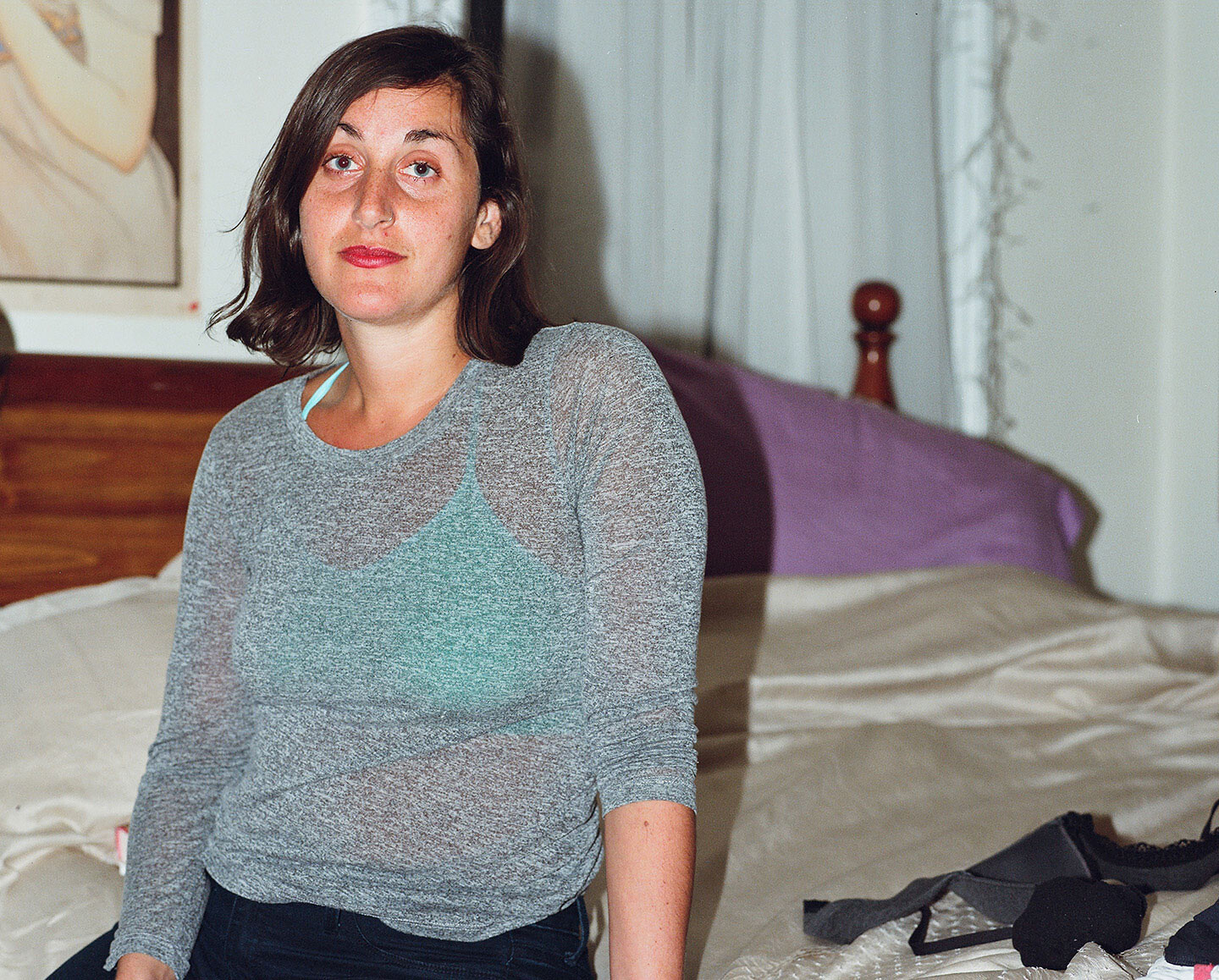

Danielle photographed by the author.
Part 2: Good Gender
Danielle:
I went to see a doctor. I was probably fifteen? She walked in and the first thing she said to me was, “Ohhh, you’re a pretty PCOS [Polycystic Ovary Syndrome] patient.” And I’ll never forget it because that was before I knew much about PCOS, but that implied that people with PCOS are ugly. And I guess I was flattered, which was sad.
I remember trying to deal with PCOS well because they prescribed me Metformin, which is the same drug my grandfather was on for diabetes. Basically, when someone tells you that you can be “cured” of your PCOS symptoms, that implies that you’re gonna be beautiful and skinny. So I made myself take Metformin three times a day and it made me extremely nauseous. There was a summer in high school where I went home every night in extreme nausea, but I just kept taking it cuz I figured I’d be beautiful and all my problems would be solved if I could just handle Metformin three times a day. But eventually I gave that up. It was a bunch of bullshit, it made no change.
From what I understand, it’s a problem of insulin resistance. You can address this yourself by eating the right food, and by exercising and taking care of yourself. My concern is my reproductive system and eggs—if all of that works properly due to PCOS. No one really knows. The problem with the syndrome is that there are a lot of question marks. Right now I don’t treat it, I just live my life and try to be healthy and take care of myself. I’d rather not be on random pharmaceuticals if I don’t have to be.
When you Google “Polycystic Ovary Syndrome,” a hormonal disorder common among women of reproductive age, you might stumble upon St. Wilgefortis. Her new, unofficial, post-liturgical-purge identity is the patron saint of PCOS.
I was diagnosed with PCOS at age twenty-two after a number of years of very irregular periods, combined with an inability to lose weight. From a young age I also experienced “abnormal” hair growth (hirsutism) and high levels of testosterone. My doctors handed me some literature on the syndrome, its symptoms, treatments, and possible severe long-term effects, such as uterine cancer and diabetes. The literature mentioned that in the medical field, PCOS’s nickname is “The Thief of Womanhood.”
Hearing this term marked the first time I began to think more critically, rather than physically, about what this syndrome represented, and why I felt a deep sense of shame. It was the first time that the physical symptoms—facial hair, lack of ovulation—seemed to be theorized outside of my body, and thus a self-reflexive moment was possible. PCOS reveals how the medical-industrial complex is closely linked to capitalist gain, and how both of these are tightly bound to controlling the gender binary and reproducing it for profit. The symptoms themselves are described in terms of deviations from the heteronormative “female” body (such as the ability to reproduce) and from the expected feminine presentation (hairless face, slim body, clear skin).9 As described in the pamphlet my doctor handed me, the syndrome makes you less womanly, less desirable, and less productive in a hetero-capitalist society. Just “less than.”


Screenshot of a message board on a PCOS page detailing different conversations and concerns of the community, 2019.
There are myriad PCOS groups on Facebook, along with numerous online forums, message boards, and meetups. These online spaces are often filled with cis women from around the United States who are genuinely heartbroken by their inability to conceive a child. What stands out on these platforms is not just PCOS-related experiences of infertility, but a wider and deeper feeling of inadequacy. These women report feeling “less than” because they cannot perform as AFAB people and meet the expectations of reproduction, since people with PCOS often cannot conceive.
The only reason PCOS exists as a “syndrome” and not just as individual symptoms is because the medical industry is committed to perpetuating and depending on a binary that has only furthered its scope since hormones were sexed “male” and “female.” Information about PCOS that is disseminated in the doctor’s office reinforces this binary. Nonbinary, gender-nonconforming, and trans people are excluded from this dominant discourse about PCOS. Each body that experiences PCOS has a different reality of it and its affects. Many spaces and situations, whether the doctor’s office, church, or a first date, continue to enforce silence and cruelty around gender difference, expression, and experience.
Around the time that I was diagnosed, I was also starting to identify my own queerness, which has no doubt informed and influenced the way I have come to internalize gender and its presentation, as well as unpack it. I wonder, at times, if my queerness—a marker of difference and even of potential danger—is exactly what protects me from feeling truly “afflicted” by PCOS. I feel no responsibility to bear children, either physically or politically. Responsibility does not always equate with desire, of course.
Sociologist Celia Kitzinger observes that historically,
medical research has linked PCOS with “abnormal” sexuality: for example, Meyer and Zerssen (1960) identify a “deep-rooted insecurity” concerning the sexual role of patients with hirsutism, especially those with PCOS, but report that “complete masculine identification and overt homosexuality seem to be rare”; Money and Clopper (1974) note that dating and romantic interests are frequently disrupted, though “bisexuality and lesbianism are not, in general, a problem”; and Gorzynski and Katz (1977) report an apparent increase in sexual drive in women with PCOS, and suggest that “a sense of uncontrollable sexual urge may be distressing (or at least puzzling) to the young woman with polycystic ovaries.” Two studies have reported an apparent link between PCOS and female-to-male transsexualism (Bosinksi et. al., 1997; Futterweit, Weiss, & Fagerstrom, 1986). A comparatively recent case study of a woman with PCOS (Michael, Zolese, & Dinan, 1996) speculates that her “abnormal” sexual desires were influenced by physical unattractiveness. The recurrent assumption is that failure to conform with feminine appearance leads to deviant sexuality.10
This research seems to suggest that sexuality in “women” is correlated with their level of masculinity: less masculine women have a more refined and lower sex drive and deviancy rate. Of course, deviancy is historically linked to the pathologizing of queerness and homosexuality, and to “promiscuous” behavior of any kind. Each of these assumptions is false. They fail to account for the varying ways in which women, femmes, nonbinary, and trans people express their sexuality and desire. It seems disturbing to associate a physical syndrome with identity and sex drive, yet it is one of the easiest ways to denigrate a body and consider it outside the realm of “normal.” Although rooted in a progressive “feminist perspective” on PCOS, this research falls flat because it identifies queerness and homosexuality as “symptoms.”
Kitzinger highlights the recurrence of the word “freak” in many women’s own accounts of their PCOS, especially in indicating their feeling of standing outside of “normal ‘femininity.’” In her studies, she notes, “nearly a third of women used the term ‘freak’ (or ‘freaky,’ ‘freakish’) specifically to describe how they felt about themselves, or the condition, and virtually everyone talked about feeling ‘abnormal,’ ‘unwomanly,’ ‘weird,’ ‘different’ in some way.”11
Despite her analysis around sexual deviancy and its correlation to queerness, Kitzinger is one of the only researchers who has considered AFAB people from a sociological and perhaps “feminist” lens. She must also be credited with giving voices to those with PCOS outside of the realm of judgment; instead, Kitzinger shared the psychological effects that such a syndrome and its stigma manifest.
With all this in mind, I have recorded experiences shared with me by others who have PCOS. These voices shed light on the varied experiences of PCOS. They also reveal how the queerness of the syndrome connects to the queer legacy of Wilgefortis. It has become clear that people with different gender identities/presentations, within different social and cultural contexts, have very different experiences of the syndrome and its effects.12
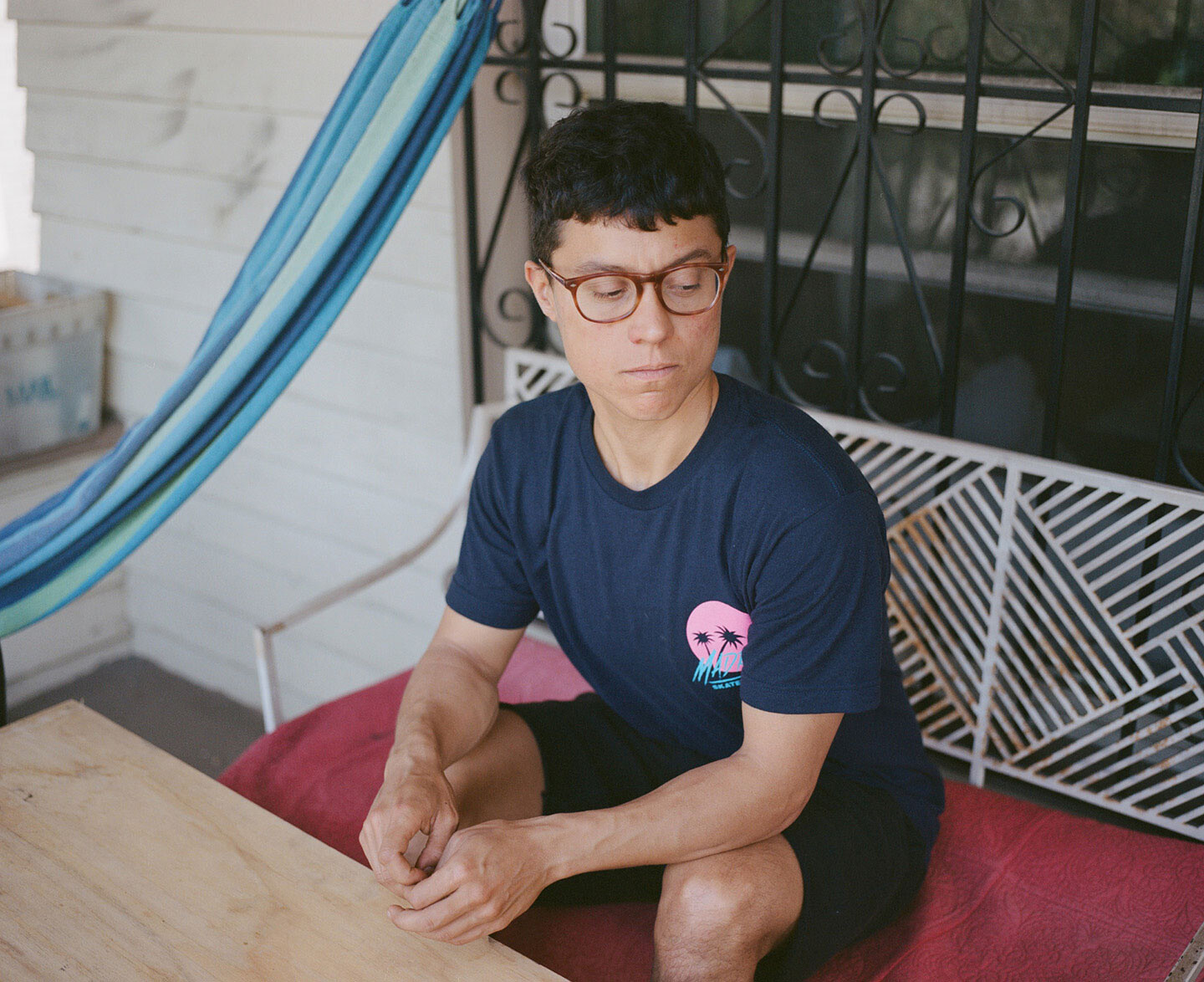

Clara photographed by the author.
Clara:
I definitely don’t present that feminine. But that is hard to connect with a medical condition because I’ve been like this since I can remember … It preceded me having my period, being sexual. I just knew I wanted to wear boys’ clothes … I’m not attached to the word “gender” at all. When people are like, “Oh, you have a really cool gender,” “You’re gender is great!” I don’t even know what that means. What is ascribed to gender there? It’s just not something I’m very connected with … like how gender presentation is this thing that can be recognized beyond the fields of being “female” or “male.” I mean, I understand that there is more nuance, but I don’t understand the word “gender” attached to that conjunction of sexuality, sociability, aesthetic, appearance, you know what I mean? That is kind of what is supposed to manifest in gender, but I just don’t understand how “good gender” as a word addresses that kind of matrix of markers.
… I want to be capable of doing things that bring this separation between female and male closer and debunk [the separation] in a way. That was a big task for myself. Like fuck this, that’s bullshit. I can do anything that I want, not because I am this kind [of person]. I [know] I am going to be told that I can’t, but I just try and I just do it. It’s not that difficult … So my understanding of myself is connected to, willingly, being kind of what I am not supposed to be.
I do not see gender as a fixed identity, or one that has specific roles or presentations associated with “man” or “woman.” However, I do still feel pressure to present myself to the world in a certain way, a “feminine” way. My queerness and politics do not protect me from this pressure, from seeking security and power through an expected gender presentation. And although I would like to think that the people I am attracted to would still want to fuck me if I let my beard grow, in truth I’m not so sure; I don’t yet feel safe in making this assumption.13
It was precisely this feeling that led me to research historical figures whose bodily presentation (like having a beard) stood in opposition to their assigned-at-birth genders, at least by traditional gender standards. Maybe I was looking for friends (and strangely close to home, given my own Catholic heritage).
By no means are the depictions of womanhood found in the story of St. Wilgefortis universal. Hers is first and foremost a story of a white woman in Europe with a beard, an aberration worthy, apparently, of sainthood at one time. Had she been of a different class, or a woman of color, the account might have ended there—or at least differently. Since some sources racialize Wilgefortis’s suitor, it is perhaps her whiteness that protects her from further violence, even elevating her to holiness.


Aaron photographed by the author.
Part 3: The Binary Collapses
Aaron:
It just seems to me that doctors—or maybe no one has explained it to me, but I would have hoped that someone would have … But sometimes I just don’t think that doctors understand what hormones do in the body, so there is this sort of black-and-white thinking about it. Which you see a lot right now, in the way testosterone is spoken about in terms of athletics, and the inclusion of trans and intersex people in athletics. And the way that testosterone is talked about as the male hormone, which of course is false, because everyone—well not everyone, but most people’s bodies regardless of gender—produce testosterone in varying amounts.
That binary collapses under closer scrutiny. I sometimes wonder, do people fully understand how hormones regulate certain aspects of the body?
For me there wasn’t so much I needed to necessarily treat. From the perspective of affirming my own gender, I don’t need to be adding estrogen to my body … Even though birth control was suggested to me a bunch of times, even before I was diagnosed, I feel like I never understood it that well. It just wasn’t really ever explained well to me. Instead, it was just “this is what you have, and here is one way to treat it.” Most other things I have learned about it come from talking to people or looking on the internet.
Magdalena Ventura is probably one of the most recognizable historical women with a beard. Painted in Spain by Jusepe de Ribera in 1631, Ventura is pictured breastfeeding her child and standing in front of her husband. The depiction here can be taken in many ways. For one, being pictured with the child affirms Ventura’s “femaleness.” For another, her healthy and conspicuous beard and position in comparison to her husband affirms her power and place. This may also be connected to her class status. Perhaps she has gained an unquestionable middle ground of power and visibility by being neither easily feminized nor relegated to freakdom—as would come to mark later experiences of PCOS.


Jusepe de Ribera, Magdalena Ventura with Her Husband and Son or The Bearded Lady, 1631, Spain. Oil on canvas. Photo: Wikimedia Commons/Public Domain
For women with beards in the nineteenth century, the ambivalent power afforded to them by their facial hair unfolded differently. Annie Jones, who was sold to P. T. Barnum’s traveling show as an infant, and Julia Pastrana, an indigenous Mexican woman, experienced very mixed forms of acceptance. Jones was part of Barnum’s “Freak Show” and died at a young age while campaigning to abolish the term “freak” from sideshow acts. Pastrana was nicknamed “ape woman” for her facial features and long hair that covered her whole body. She was also subjected to further display in death. Her body was stuffed and preserved and toured posthumously, robbing her of any agency she had over her own representation. I thought of Pastrana when I encountered artist and photographer Zoe Leonard’s bearded woman photograph series from the early 1990s, which shows the stuffed head of a bearded woman that was preserved as a museum specimen. Leonard photographed the head from three angles in black and white. Although Leonard’s photographs might be motivated in part by her own outrage at the treatment of this woman, they may nonetheless inflict further violence against her, insofar as they offer her to be yet again stared at without any further information or attention to her identity or worth.
Other nineteenth-century women capitalized monetarily off their bearded status—some more successfully than others. Madame Clofullia traveled with Barnum’s “American Museum” for many years, and historical accounts of her life seem to indicate a degree of praise and respect from mainstream audiences. In some cases, feminine performance can compensate for non-feminine appearance. Whiteness and upper-class status also help.14
Today, there remain both psychic and monetary costs of maintaining a “feminine” presentation. Some bodies must work harder—and spend more money—to be seen as they would like to be seen, and be treated as they would like to be treated. Personally speaking, as a hostess in my early twenties at an upscale New York City restaurant, I could never show up to work with any hint of “unnecessary” facial hair, let alone a beard. But as an artist’s assistant in my late twenties, the expectations and boundaries of self-presentation were more blurred. I needed both jobs equally in order to support myself, but by gaining social and artistic capital, I was able to access workspaces where I could afford to not perform a “feminine” appearance so deliberately.
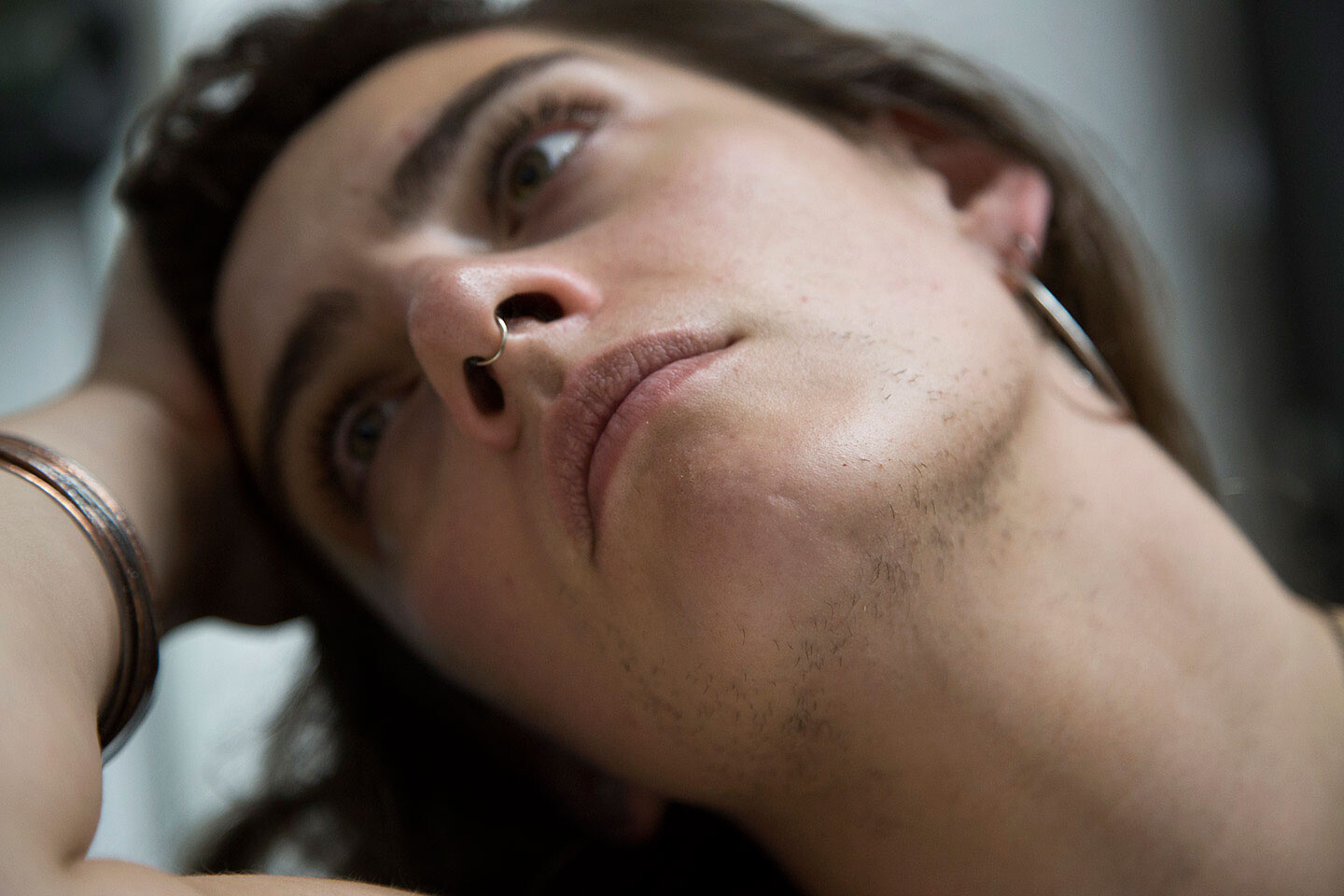

Self-Portrait of the Thief of Womanhood, Brooklyn, New York, 2018.
As a queer body in the twenty-first century—not personally attached to defining my gender in a specific and/or fixed form for the most part—I am committed to dismantling and tearing apart the notion of a binary. But my body is also filled with the privilege of whiteness and cis-ness (or at least the predominant presentation of cis-ness). Thus the impact of my identity on my daily experience is relatively minor.15
So why continue to fight my natural presentation? I have a beard, but I do not love my beard. I am not proud of it. And sadly, I certainly do not find power in it. Not consistently at least. In fleeting moments, perhaps. Theoretically, I know this is bullshit; I know I should find extreme confidence in my beard. The gender binary and its violent history are written onto me; they shape how I perceive my own (queer) body. Other bodies that I desire, the lovers I take, fantastically challenge this conventional gender presentation. I fall deeply in lust for that which cannot be labeled and owned by a violent gendered history. Yet I persist in paying $50.00 every month to control my appearance.16

Various hair removal products. In order to contend, you must spend. Here are some of the things that a person with PCOS might spend money on, such as:
Jolen bleach: $6.40
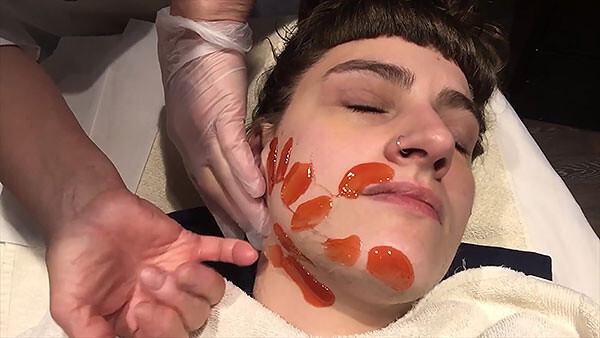
Waxing treatment, whole face except eyebrows: $45.00 + $9.00 tip × 15 = $810 per year.
A full-face wax costs about $50.00. This is the price affixed to performing and maintaining what I desire to be seen as. When does violence become self-inflicted and to what ends? How can we be liberated from ideas of gender and queer the world if we consistently are in the process of undoing our own notions of constriction?

Gillette Venus Extra Smooth women’s razor blade: $7.99

Nair facial hair remover cream with sweet almond oil, 2 oz: $4.69.
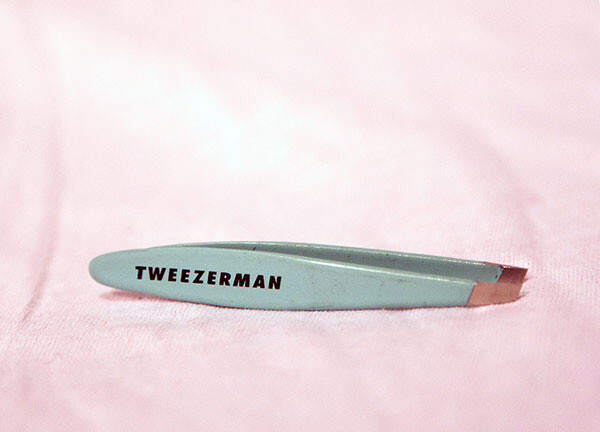
Tweezerman, mini slant tweezer: $15
Various hair removal products. In order to contend, you must spend. Here are some of the things that a person with PCOS might spend money on, such as:
Jolen bleach: $6.40
When my facial hair first started to appear in eighth grade as a mustache, a close friend (a cis man) pointed it out and laughed. I started using any available method to hide it. First, it was bleach, then Nair, and eventually self-waxing. When my beard started to come in, at around age eighteen, I added electrolysis treatments. But nothing has worked permanently. I continue to go to professional waxers, but also let my beard be somewhat visible at times. I attribute this mainly to my queerness, and my own slow churn towards undoing and unlearning rigid binary ideas of gender and representation. Another factor is, honestly, fatigue: maintenance can be tiring and expensive. I also exist primarily in communities and spaces where my face as-is, for better or worse, is not unacceptable and does not make me vulnerable to violence or danger. It helps to have become somewhat liberated from internalizes gender binaries and dependence on economic situations where I could not openly be who I am.
The gender binary can only persist within structures that also inflict violence more broadly—policing, prisons, capitalism, the state, to name a few. Such structures perpetuate a system in which there is no room for the “in between” or the undefinable. It is precisely the precarity of queerness that renders it beautiful and tragic all at once. To live and fuck in the way one desires, outside of the belief system of capitalist patriarchal productivity, is to live in a constant state of pleasure mixed with terror. But this mixture also leads to a kind of freeing euphoria.
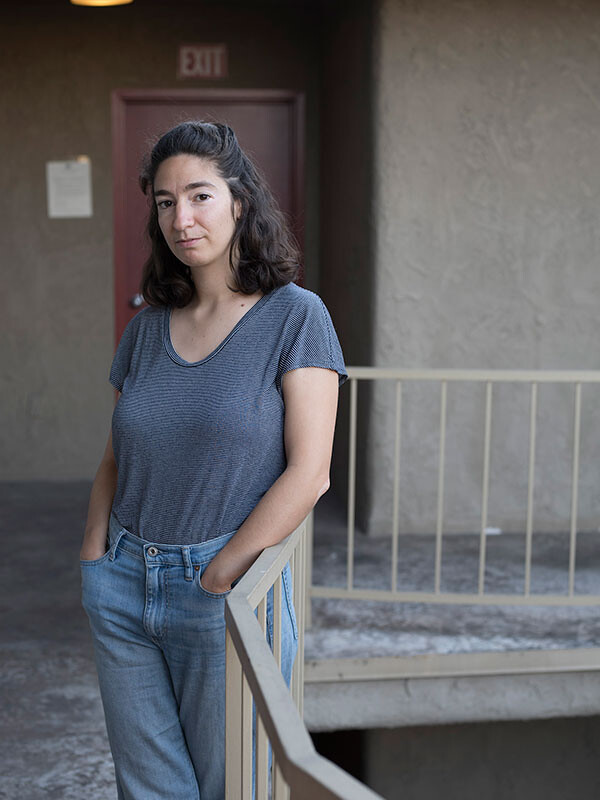

Rachel as photographed by the author.
Part 4: Gay Anatomy
Rachel:
I definitely get a knot in my stomach, very nervous, thinking about it, talking about it, but in a way that feels productive and destigmatizing for myself. I have internalized a lot of shame around it … Even when I think about you doing a project, that means you are talking to multiple people, who are all thinking about this. That is deeply comforting to me. I’m sure I could google it and there are groups online, I’m sure … But I haven’t, I haven’t looked into this on my own.
I think it’s about gender. It’s also, for me, tied to sexuality. Leaning a little more into having PCOS is concurrent for me with leaning more into thinking intentionally about my queerness, and about my femme-ness. They are happening together.
The more I’m able to accept and think about my PCOS in an open and self-conscious way, in a way that actually feels good, the more I’m able to talk about my queerness, and about the fact that I’m not the most femme. Some days I’m more femme than others. For me they are all part of one conversation.
What my body can do, how I present my body, and how my body is sexual—they are all part of the same thing.
St. Wilgefortis’s story of martyrdom is multiply queer. Her female body, made unruly by her miraculous beard, queers Christ’s body. Or, as art historian Ulrike Woerner told me in an interview this summer about her research on St. Wilgefortis: “She was developed in a certain social situation of religiousness in the 15th century where you had the first women’s movement in religion and Christianity, in the Catholic Church. At this time you have only the Catholic church, and in this spirituality this figure was developed as a figure of salvation and power mostly for women, but not only. And it’s not only to help against violence, that’s her second function, but she is first a figure for women to have a female salvation figure, not only a male salvation figure.”17
There has always been queer representation within historical record. St. Wilgefortis is particular to the Catholic faith, but she has also served as one of the only visible icons that exists for people outside of the gender binary. Additionally, she has been adopted and brought into the PCOS community as a patron saint to the symptoms, and perhaps a signifier that a PCOS experience is only “abnormal” within a techno-scientific paradigm, that our experience is not lacking or incomplete or less than, and that there is power in that.
Historian Lewis Wallace argues that Wilgefortis’s “so-called disfigurement” was in fact deeply ennobling:
Wilgefortis’s beard is meant to rob her of beauty, but as we have seen, it is precisely this so-called disfigurement that brings her closer to Christ and ultimately leads to her sainthood. Wilgefortis’s loss of feminine beauty is her miracle; what is presented as her ugliness makes her identical to Christ. This particular paradox does not appear with such precision in any other virgin-martyr narrative. In the case of Wilgefortis, we see not merely female eliding into male but also deformity eliding into perfection.18
I do not think it is my PCOS that has made me queer, but I do see PCOS as a strangely beautiful and accidental queering of the body, or of my body at least. In conversation with Rachel, I responded to her statement above by saying:
Most of the people I’ve talked to about this are queer, you know. Some people are in certain types of relationships, and some aren’t. It’s funny because I think about it as a queering of the body, if we are going to think of bodies as binary, biologically. Then this is a pushback, which I find to be so cool. This is like “Gay Anatomy.”
Through obsessive thought and research on PCOS, I have come to realize that I feel farther from womanhood than ever before. It feels disingenuous for me to claim my womanhood when I no longer believe in a gender binary. At the same time, it also feels wrong to not recognize that people’s experiences are culturally shaped along gender lines.
In essence, I have come to undo and unlearn much of what I have internalized about gender over time. A friend recently told me that when we first met, he had no doubt that I was “genderqueer, or just very androgynous.” In that moment I felt held and warm. I have clung to womanhood and femininity for so long because it has brought me comfort and community. Those are not things I wish to lose. I still do, and always will, love women and womanhood—I just don’t think they mean the same things to me as they once did. Today I find myself wanting to shake off the entire complex of gender identity. I wish to float in ambiguity, but not sink. I know I am not alone in this.
Last week I was walking with my lover, my person, from the library to her house, when she shared thoughts she had the first time we met. Her roommate had told her that a friend named Sam was coming over, who she assumed was a (cis) man. When I arrived, she was immediately intrigued, she said—tall, deep voice, and obviously not a (cis) man. She just didn’t really know what my gender was, and that’s what initially attracted her, she said. Earlier that day I had told her that no one has ever made me feel so at ease and so desired in my body. We held hands, walking along Echo Park Lake in Los Angeles. My beard was just visibly growing back in.
Grace Lee Boggs, The Next American Revolution: Sustainable Activism for the Twenty-First Century (University of California Press, 2011), 79.
Ilse E. Friesen, The Female Crucifix: Images of St. Wilgefortis Since the Middle Ages (Wilfred Laurier University Press, 2001), 107.
Another purported origin of Wilgefortis’s cult is that she was confused with the Volto Santo, a Roman Catholic crucifix of Jesus Christ dressed in regalia, including a dress-like gown.
It should be noted that some of these accounts specifically identify the suitor as Muslim. Wilgefortis’s refusal and commitment to Christian purity has thus also been subject to Islamophobic and potentially racist interpretation.
“By the directives of Sacrosantum Concilium of Vatican II (1963), in which one can find the statement that ‘incongruous’ practices may ‘foster devotion of doubtful orthodoxy.’ Zealous efforts, both before and following these new directives, resulted in numerous churches being stripped of any traces of the former veneration of the crucified female saint—often to the pride of certain clerics, but to the regret of numerous parishioners and visitors.” Ilse E. Friesen, The Female Crucifix: Images of St. Wilgefortis Since the Middle Ages (Wilfred Laurier University Press, 2001).
Friesen, The Female Crucifix, 94.
Caroline Walker Bynum, “The Female Body and Religious Practice in the Later Middle Ages,” in Fragments for a History of the Body: Part I, ed. Michel Feher (Zone Books, 1989).
Mark Albert Johnston, Beard Fetish in Early Modern England: Sex, Gender, and Registers of Value (Routledge, 2016), 181.
All of this is rooted in historical and contemporary white, Eurocentric, classist, and ableist beauty standards.
Celia Kitzinger, “‘The Thief of Womanhood’: Women’s Experience of Polycystic Ovarian Syndrome,” Social Sciences and Medicine, no. 54 (2002).
Kitzinger, “‘The Thief of Womanhood.’”
Experiences of hirsutism vary regionally and culturally. My experience as a white woman living in the United States is particular. I cannot speak to the experiences of women of color and or those in different regions where culturally and religiously specific notions of beauty and femininity, along with the effects of colonialism and white supremacy, are felt on a bodily level. In an ideal future version of this text, such voices would also be included.
That said, I have been pleasantly and genuinely surprised by select lovers who have accepted and even been attracted to this aspect of my presentation. For that I am forever grateful. Those moments have yielded true intimacy and growth.
“Why did Clofullia’s Victorian American audiences respond so favorably? Partly it’s because she ‘acted’ like a nineteenth-century woman. In a society with deeply entrenched gender norms, Clofullia fit the part: She was demure, nurturing, and demonstrated excellence in needlework and other ‘feminine’ arts. In the face of all this, what was a beard?” Sean Trainor, “Lesson of the Bearded Lady,” The Atlantic, December 5, 2015 →.
PCOS affects a variety of different AFAB people regardless of race or ethnicity, and experiences may also differ based on different cultural or regional understandings of beauty standards.
Lewis Wallace, “Bearded Woman, Female Christ: Gendered Transformations in the Legends and Cult of Saint Wilgefortis,” Journal of Feminist Studies in Religion 30, no. 1 (Spring 2014): 54.
Ulrike Woerner, in conversation with the author, August 2019.
Lewis Wallace, “Bearded Woman, Female Christ: Gendered Transformations in the Legends and Cult of Saint Wilgefortis,” Journal of Feminist Studies in Religion 30, no. 1 (Spring 2014): 54.
Category
Thank you to everyone who worked with me, talked to me and leant their stories, knowledge and thought to this ongoing exploration. I am forever grateful for your time and generosity: Aaron Kelley, Clara López Menéndez, Danielle Schwab, Rachel Smith, Ulrike Woerner, Sara Frier, Virgil Benjamin Taylor, Johanna Bampi, Robert Mills.

